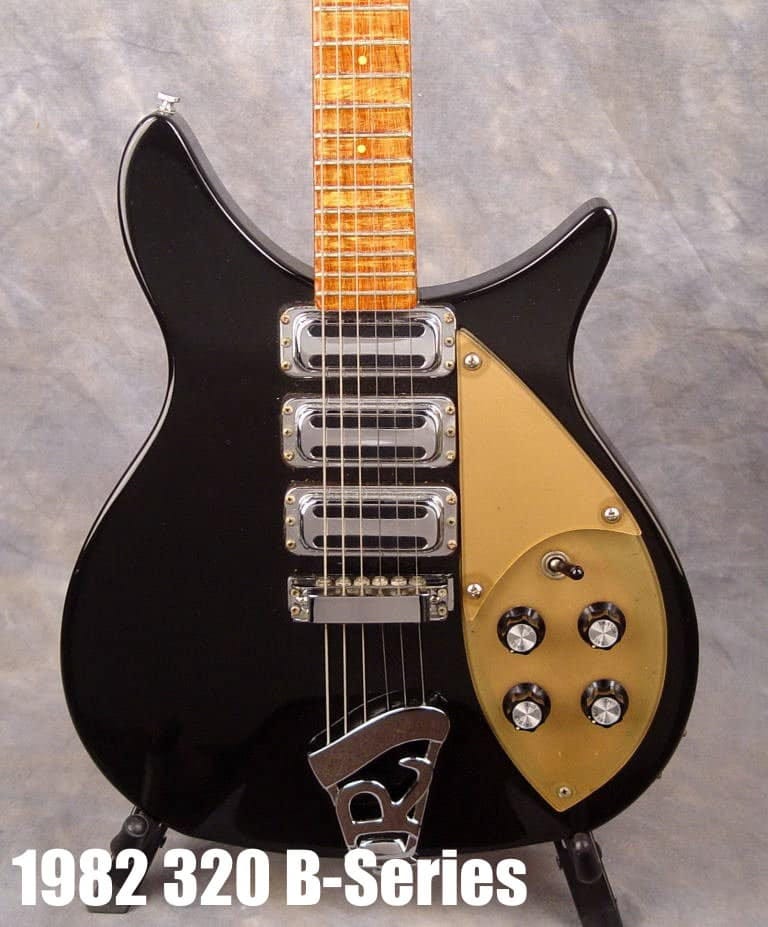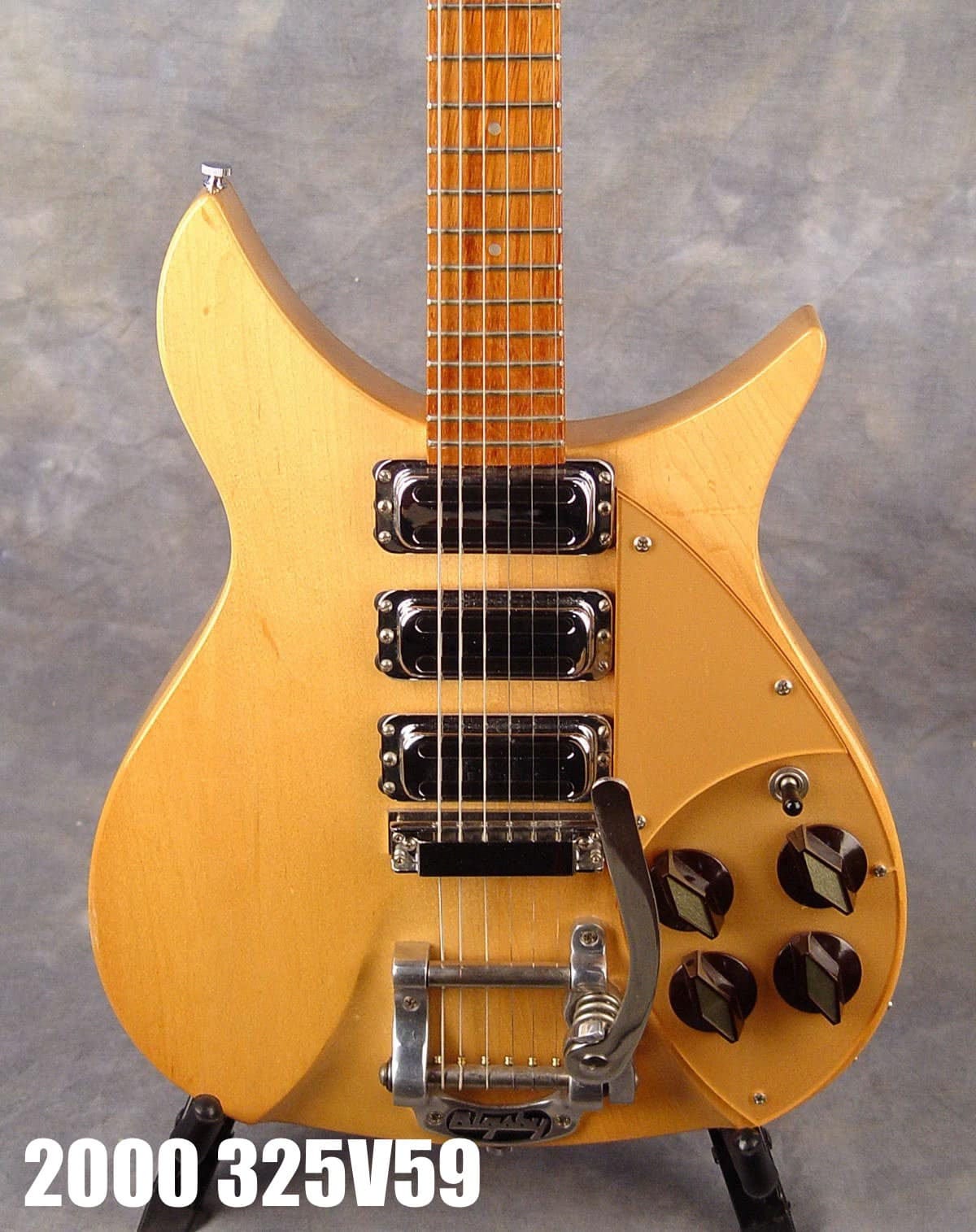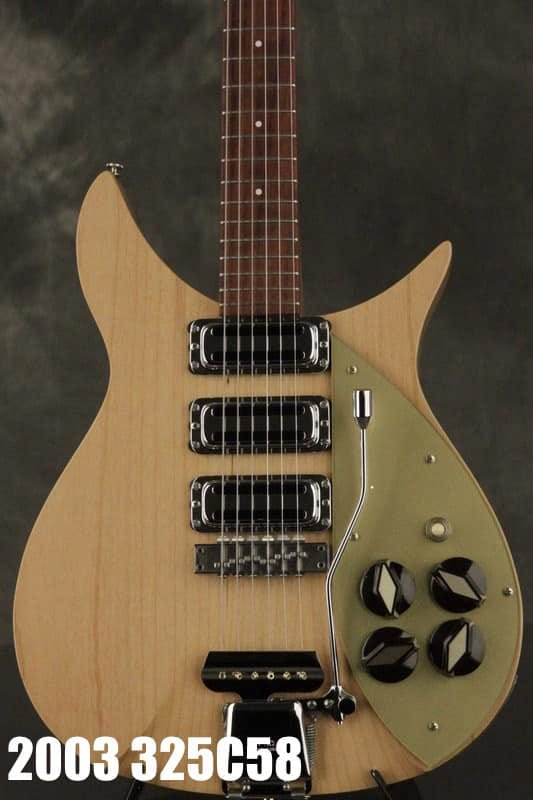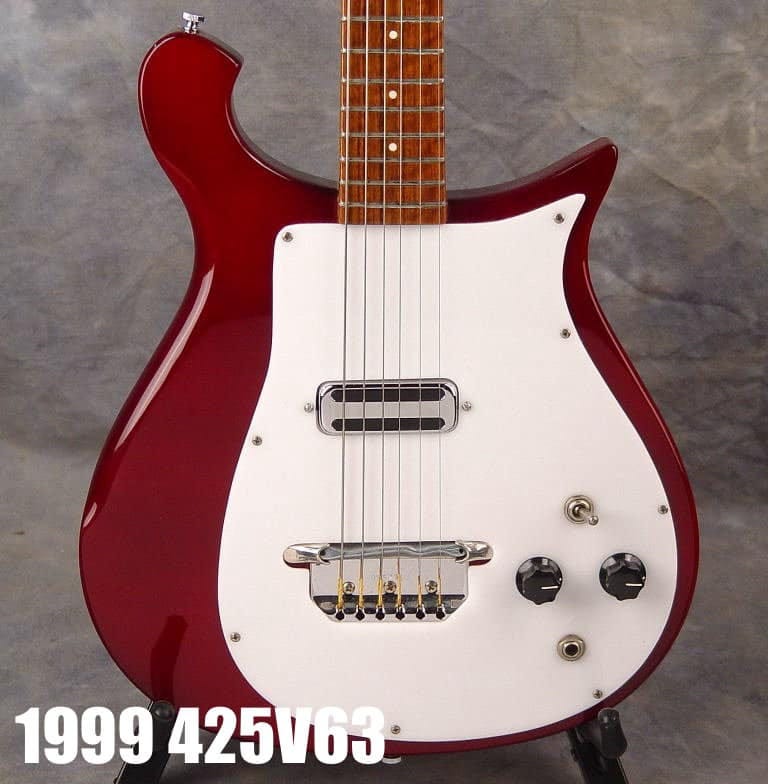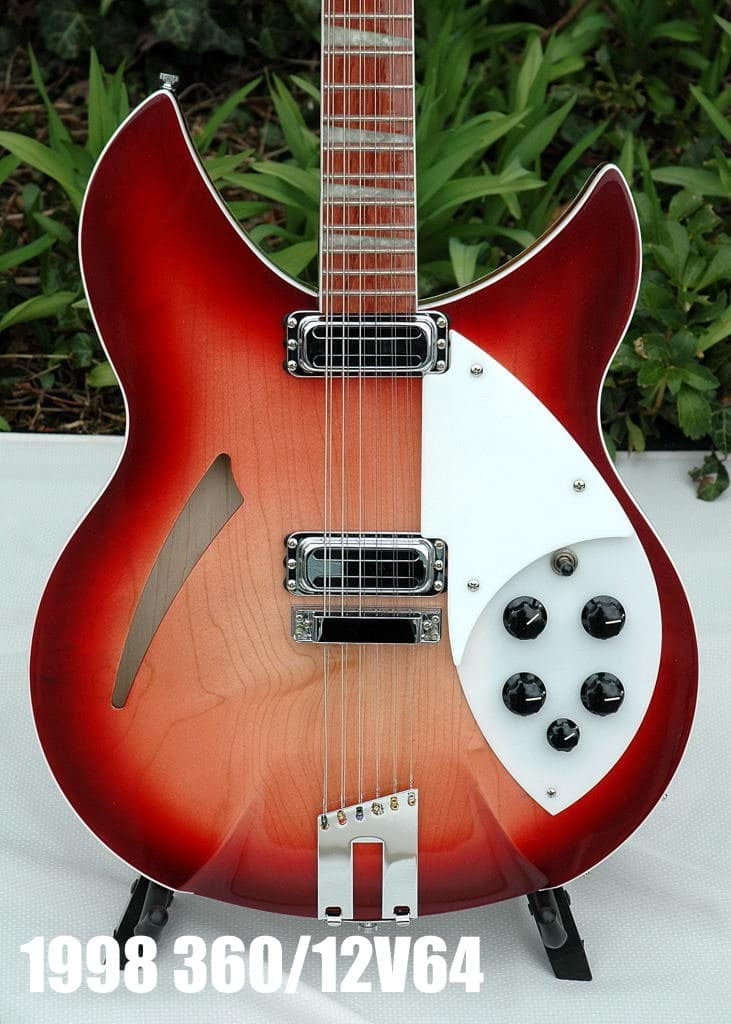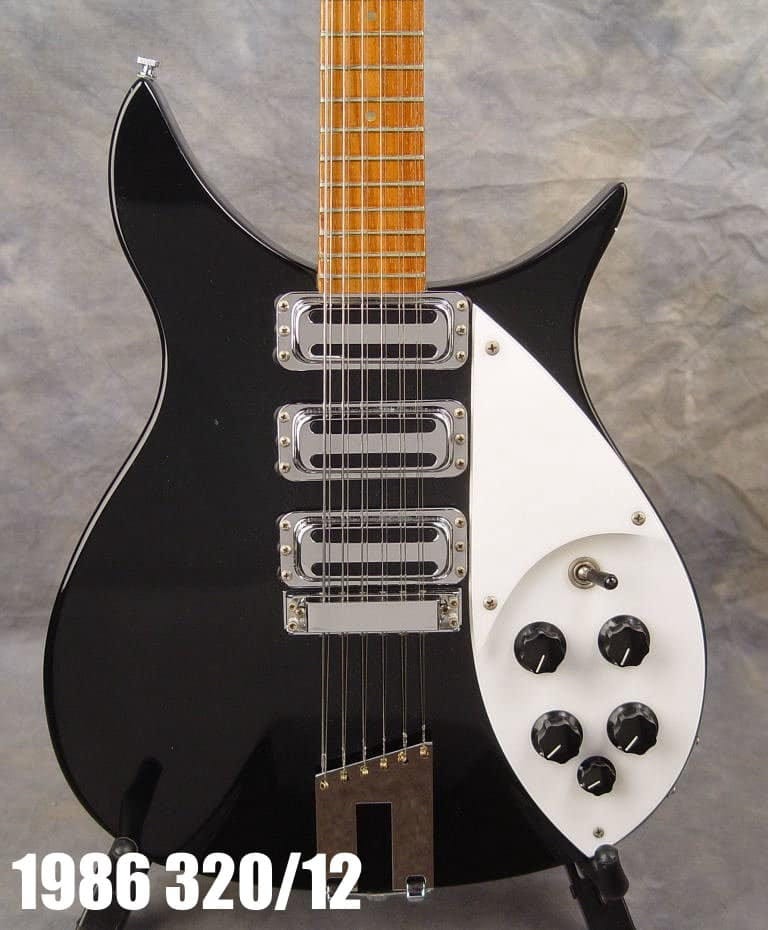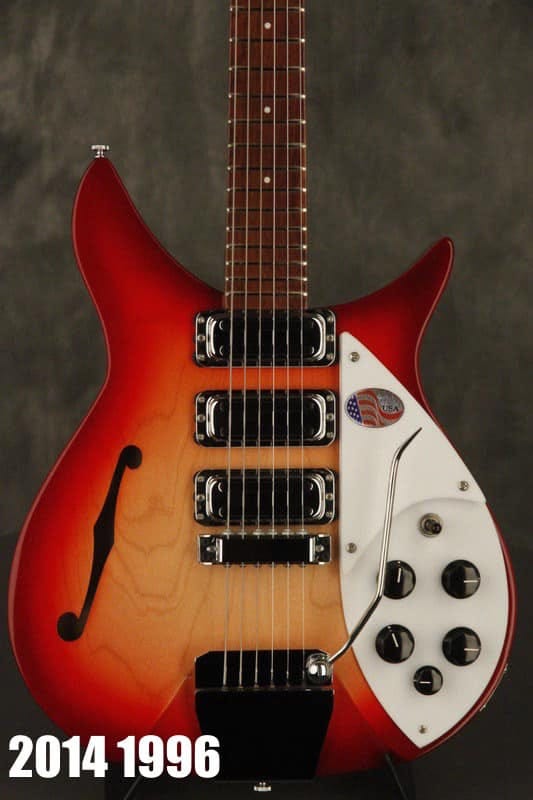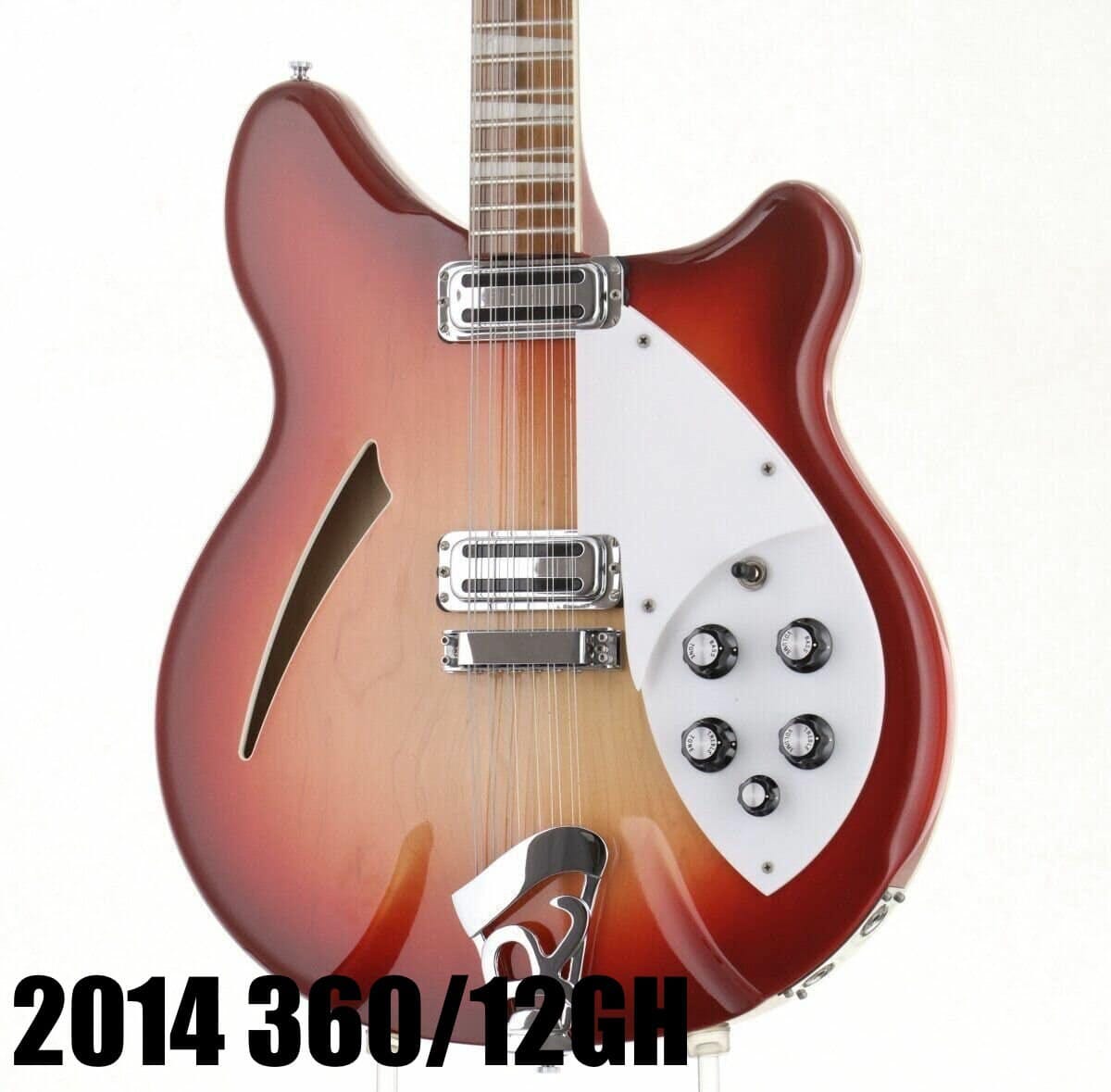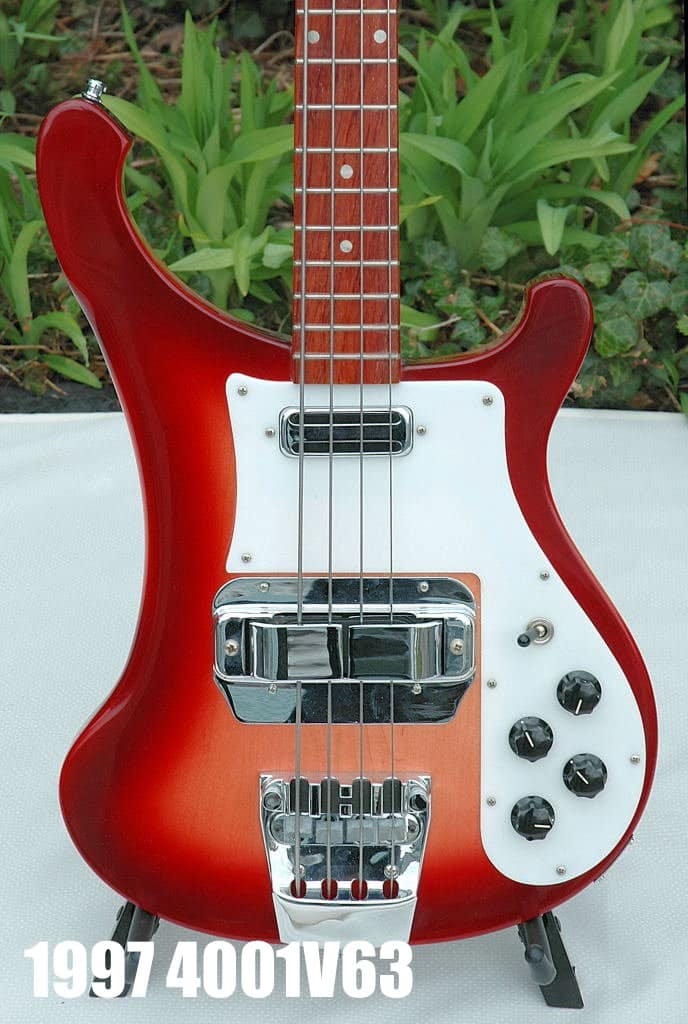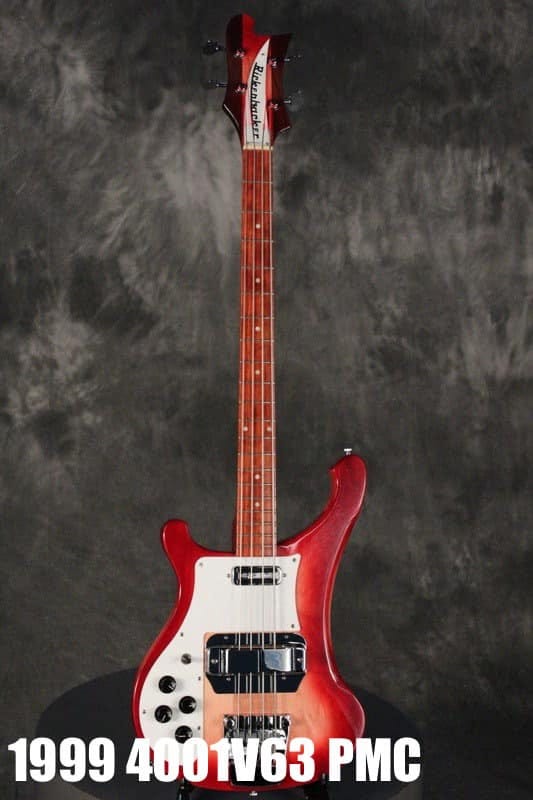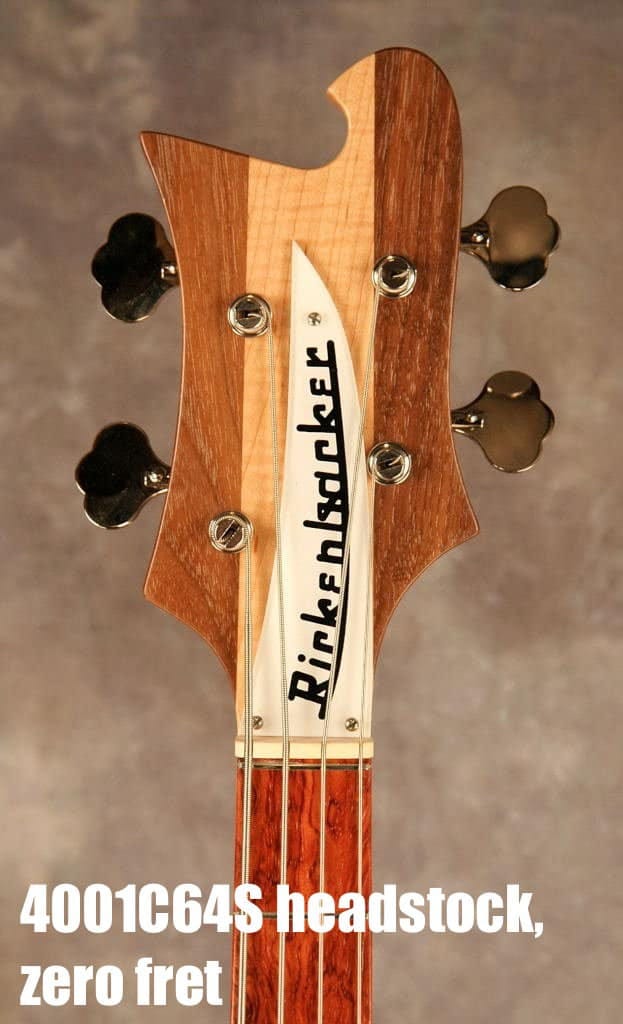Beatles Inspired Models
Rickenbacker Beatle reissue guitars. Man, there have been so many of them it’s hard to keep them all straight! Well, we’re gonna dive in today and try to do exactly that. Now if you have detailed questions, Bob Belloff runs a great “Gear of the Beatles” group on Facebook that can answer any specific or ultra-specific questions (and man, do Beatles fans get ultra specific!). But this should be a pretty good high level overview. Ready? Let’s go! So we’ll begin with the “actual” Beatle-owned-and-played guitars that inspired the reissues before we talk about all the different versions of said reissues. As I count it, there are 8 guitars we have to deal with. In order of acquisition, they are as follows:
1958 325 Capri (John, purchased in Hamburg, Germany, Fall 1960)
1962 425 (George, purchased in Mt. Vernon, IL, September, 1963)
1963 360/12 (George, presented by F.C. Hall in New York, NY, February, 1964)
1964 325 (John, delivered from the factory to The Beatles’ hotel Miami, FL, February, 1964)
1964 325/12 (John, delivered to Brian Epstein, May, 1964)
1964 1996 (John, donated by Rose Morris, December, 1964)
1965 360/12 New Style (George, gift from B-Sharp Music/WDGY radio, Minneapolis, MN, August 1965)
1964 4001S (Paul, presented by FC & John Hall, Beverly Hills, CA, August 1965)
Each one of these guitars has received at least one official or unofficial “reissue” or “inspired by” or whatever you want to call it. What we’re gonna do is discuss the original specs of each of these, and then each of the reissues of that guitar, and where they got the specs right or wrong. Simple enough? Let’s go!
So we’ll start with arguably the most famous of the bunch: John’s 1958 325 Capri. A TON has been written about this guitar and all the things he did to it, but as it originally left the factory for the trade show circuit in 1958—the very first short scale Capri built—it featured a 2” thick semi-hollow alder body with a Natural finish, 3 toaster pickups, Grover exposed gear “Sta-Tite” tuners, a Kauffman Vib-rola with roller bridge, a “long” output jack plate, and only 2 chrome control knobs (as used on lap steels) on a one level gold pickguard. The guitar returned to the factory and the controls were upgraded to a four knob layout with Rogan knobs. This is how it was when Lennon purchased the guitar in Hamburg in 1960.
Over the years Lennon tinkered with it multiple times, and by the time it was retired from touring in 1964 it had been refinished black, the knobs had been changed to chrome Burns knobs, the bridge had been replaced with a Sorkin “bowtie” bridge, and the Kauffman had been replaced by a Bigsby B5. The black finish was later stripped back to natural. But this was the OG Beatle Rickenbacker.
The first Beatle “reissue” models were the B-Series 320, 360/12WB, and 4001, produced from roughly 1982-84. The 3 guitars in this series were designed to “evoke” the Beatle guitars without trying to accurately recreate them—and were famously hated and killed by John Hall shortly after he took ownership of the company from his father. Which of Lennon’s 325s was this model attempting to evoke? Um…the “idea” of them? Here’s what differentiates a B-Series 320 from a “normal production” 320 of the same period: 3 “hot/12K” toaster pickups instead of stock Higains (and remember that the B-Series guitars reintroduced toasters as none had been available since 1974), gold plastics instead of white—including the first plexi truss rod cover since 1976, and…that’s it. It’s just a normal early 80’s Jetglo 320 with different pickups and plastics. Let’s forget this one and move on.
The first “real” attempt to recreate the 1958 325 was the 325V59, produced from 1985-2000. If you squint I guess it looks pretty close, but once you look closer a number of problems emerge. Available in Jetglo and Mapleglo, it featured a 1 7/8” thick semi-hollow maple body with dimensions that were just a little “off” (look especially at pictures from the back!), 3 period “hot/12k” toaster pickups, Kluson/”vintage” style closed back tuners, a stock Rickenbacker bridge, Bigsby B-5 vibrato, “short” output plate, and four Rogan knobs on a two-level gold pickguard. Cosmetically…close? But wrong in several key places.
One other detail bears discussing: the headstock shape. The original 58 guitar had a period headstock that is a little bit wider than the 60’s/modern shape. The V59 had a headstock that was wider than the original, but not quite as wide as the period “paddle” headstock. As the model was being discontinued in 2000 it could be ordered in factory colors other than JG/MG so Fireglo/Teal/Midnight Blue etc examples exist.
John Hall was determined to get the next one “right”, and the 325C58 introduced in 2002 strove to get as close as possible to the original as it was when acquired by Lennon in 1960. Also available in Jetglo and Mapleglo, it featured a 2” alder body, 3 specially produced 3.5K toaster pickups (with molded “dimple” marks in the slots to match the originals), Grover open gear “Sta-Tite” tuners, a Kauffman Vib-Rola with vintage roller bridge, a long jackplate, and four Rogan knobs on a one level gold pickguard. Even the headstock shape was much closer to right. Production ran through 2010, and finding a “stock” example today can be very difficult as many have been “Lennonized” to some extent (some combination of knobs/bridge/tailpiece replaced to match later appearances). No reproduction of this original 325 has been available since.
The next “original” Beatle Rickenbacker was the 1962 425 purchased by George in 1963 during a trip to the US to visit his sister. Originally Fireglo, George had it repainted Black before he took delivery to match John’s 325. George modified it to add a second pickup and switch, silver amp knobs, and at some point the original Kluson white-button tuners were replaced with Grover “Sta-Tites”. This guitar saw limited usage, but was used onstage several times.
While not “officially” labelled as such, the 1999 425V63 limited run was pretty clearly intended to evoke this guitar. It was offered in Jetglo and Burgundy (almost all known original 62’s are Fireglo, by the way), alongside similar two pickup 450V63 models. These guitars were among the first to feature the modern scatterwound reproduction toasters instead of the previous “hot/12k” toasters. They got most things right—down to the white plastic tuner buttons on the 425 and nickel on the 450—but a couple details were wrong. 1962-64 425s and 450s featured a “short” bridgeplate, and a correspondingly smaller bridge cutout in the pickguard. The reissue models had the longer bridgeplate and larger pickguard cutout. And the 1962 truss rod cover had no “MADE IN THE USA” language, whereas the reissue did. Still, not bad.
The next Beatle guitar on the list is George Harrison’s 1963 360/12, the second (behind the Suzy Arden) 12 string guitar ever made by Rickenbacker, and the first strung with the octave strings “backwards” in what is now standard Rickenbacker fashion. The guitar was brought (along with a 4001S) from California by F.C. Hall in February 1964 to show/present to The Beatles while they were in New York appearing on the Ed Sullivan Show during their first trip to the US. George was not feeling well and did not come to the meeting, but John was so impressed by the guitar he took it and Hall across the street to George’s hotel room for George to play it. The rest is history.
You can probably draw this guitar with your eyes closed, but it was a Fireglo “Old Style” flat top double bound 360 body with a trapeze tailpiece. Built before crushed pearl inlays became standard on Deluxe guitars, it featured white plastic triangle inlays and red side dots. It’s not an understatement to say that this guitar in those hands added a whole new palette to the popular music landscape.
Just like John’s 325, the first “evocation” of George’s 360/12 was the B-Series 360/12WB of 1982-84. Essentially a production Fireglo 360/12WB with some special features, what made it different from a stock guitar of the same era was the “hot/12k” toasters and the plexi truss rod cover. That’s it. Anachronistic/inauthentic features included a bound soundhole, 24 fret neck with poured inset inlays, and an “R’ tailpiece. As a 70s/80s era Rickenbacker? Cool! As a Beatle guitar? Bad! Luckily for purists the model was short-lived.
The first proper attempt was the 360/12V64 in 1986. Again, you know the basics: Fireglo double bound body, square heel, white plastic triangle inlays, toaster (albeit “hot/12k”) pickups, trapeze tailpiece, white plastics, black vintage/KK knobs. When you squint, not bad. But here’s what it got wrong. The body shape is off—you can best see it where the upper bouts meet the lower…it’s too smooth and rounded on the V64, it’s more abrupt on the original. The headstock shape is different from the original, as is the truss rod cover—which also had “MADE IN U.S.A.” printed on it where the original did not. The original had x-bracing, this one had carved channel bracing and a thicker top. This one had black instead of red side dots. And the wiring is not vintage correct. That’s not even covering picky things like bridge hardware and screws! Over the life of the model, 6 string versions were offered, Mapleglo and Jetglo examples, as well as other colors near the end of its run. Production ended in 2001.
But just as with Lennon’s first 325, the company was dedicated to getting it RIGHT on the next try. And the 360/12C63, launched in 2005, addressed every single point listed above. The body shape is right. The headstock shape is right, as is the truss rod cover shape and lettering. The bracing and top thickness is right. The side dots are red. The wiring has the treble cap on the bridge pickup. Even the picky stuff like the bridge hardware and screws are right. And of course, the hot toasters are replaced by modern scatterwounds. A handful have been made in Jetglo, but 95%+ are Fireglo just like George’s. And they’re still pumping them out today.
The next Beatle guitar on the list is the second Lennon 325, the 1964 model delivered to him just in time for The Beatles’ second appearance on the Ed Sullivan Show from Miami. F.C. Hall had noticed that Lennon’s 1958 325 as played during the first Ed Sullivan appearance was in pretty bad shape—there were a lot of miles under the hood of that guitar by then—and rushed a replacement through the factory. The original guitar was Jetglo with 3 toaster pickups, and featured an Accent vibrato with a roller bridge, Kluson tuners, and white plastics with black “KK/vintage” knobs. This became Lennon’s primary stage guitar until he purchased his Epiphone Casino in 1966.
The first “reissue” of Lennon’s second 325 was the 325V63 launched in 1986. It was a LOT better than the 325V59. Cosmetically, it was very close: Jetglo finish, 3 toasters (albeit period “hot/12k”), Accent vibrato, white plastics…it looked the part. Where it was “lacking” versus the original was mostly in hidden details. Like a standard bridge instead of a roller bridge. Like a flatter fretboard radius. Like different internal bracing. Like a truss rod cover shape that was a little off. Like a headstock and body shape that wasn’t “quite right”—it’s hard to describe what’s wrong about it, but trace an original 64 and then trace this one on top of it…there’s a noticeable difference. Overall it was close, but not quite perfect. Fireglo and Mapleglo finishes were also sporadically offered throughout the model’s run, which ended in 2001.
As part of the Signature Limited Edition series, Rickenbacker introduced three John Lennon signature models in 1990: The 325JL, the 355JL, and the 355/12JL. So what were they? Simple: a Jetglo 325V63 with a doodle on the pickguard, a Jetglo 350V63 with a doodle on the pickguard (a model we should point out, that didn’t exist in period and was never played by John Lennon but kinda looks like something he played), and a new 12 string version of the 350V63 (see previous notes about the 355V63) with a doodle on the pickguard. The end. Should they be included on this list of Beatle guitars? The first one, maybe. The 350 variants? Absolutely not. But somebody would have said “well actually…” if I left them out so here they are. The 12 string version actually got brought back in 1997 without the doodle as the 350/12V63, but it never really caught on and was discontinued in 2009. Produced from 1990 to 1993.
Now back to proper Beatle guitars. Just like the 325C58 was intended to get Lennon’s original 1958 325 “just right” and the 360/12C63 was intended to get Harrison’s 360/12 “just right”, the 325C64 launched in 2004 was intended to get the 1964 version “just right”, and it largely succeeded. Everything “wrong” I mention above? Fixed. Scatterwound toasters. Roller bridge. 7.4” radius fretboard. Period correct internal bracing. Correct truss rod cover shape. Correct headstock and body shape. They just got it right. And, like the 360/12C63, they’re still cranking them out today.
The next John Lennon guitar on the list is the 325/12. A one-off produced in 1964 for John, it answered the question “how do you keep a short scale 12 string guitar in tune and intonated?” The answer was “you do not”. Used only sparingly, what set Lennon’s 325/12 apart from its 325 father was the headstock (obviously) which featured a “stubby” truss rod cover (also seen on the first Rose Morris 1993 12-string guitars), and a trapeze tailpiece and standard bridge in place of the Accent/roller bridge found on the 6 string version.
The first reproduction of this guitar was a very limited run of 25 320/12’s built in 1986. It used the current 325V59 body with a custom neck (as there was no production short scale neck 12 string guitars) with a square heel, and featured three toaster (albeit “hot/12k”) pickups and a trapeze tailpiece with modern bridge. The one surprising detail they got right was the “stubby” plexi truss rod cover.
The next reproduction of this guitar was a run of 136 325/12’s built in 1999, and it was a little bit better. It used the current 325V63 body with a custom neck (as, again, there was no production short scale neck 12 string guitars) with a square heel, and featured three scatterwound toaster pickups and a trapeze tailpiece with a vintage bridge. However, despite the steps forward with the pickups and the bridge, they took a step backwards by using a standard 12-string plexi pickguard instead of the “stubby” version John’s original did. There have been no subsequent attempts to recreate this guitar.
The last of the John Lennon 325-style guitars was a 1964 Rose Morris 1996 acquired in late December 1964. The 58 had been retired earlier in the year, and during a show at the Hammersmith Odeon in London he dropped the 64 325 off the stage and cracked the headstock. Rose Morris stepped in with a substitute Fireglo 1996 with a 2 o’clock f-hole, and John played it until the 64 325 was repaired. Rose Morris took full advantage of the situation, advertising the 1996 as the “Beatle Backer” with John’s photo alongside a picture of the model. The guitar was later given to Ringo who later auctioned it off.
Although John’s connection to this guitar was fleeting, there have been three runs of 1996 reproductions. The first was in 2006. A 325C64 donor received an Amber Fireglo finish and a 2 o’clock f-hole. An unknown number were produced. A second, identical run of about 30 was produced in 2008. A third run, in 2014, we probably shouldn’t count as it featured an “incorrect” (as compared to Lennon’s) 1 o’clock f-hole.
George was presented with a second 12 string Rickenbacker by a local music store and radio station at a press conference before The Beatles’ August 1965 concert in Minneapolis, MN. A 1965 “New Style” 360 in Fireglo, the guitar got used on the stage in the UK later that year, in the studio during the Rubber Soul sessions, and during the final 1966 tour. It was stolen around September, 1966 and has not resurfaced.
In 2014 US retailer Guitar Center commissioned a run of 50 guitars meant to “evoke” this guitar. The 360/12GH featured a 21 fret neck (at a time when standard 360s were 24), a plexi truss rod cover, and scatterwound pickups. It did not feature other period correct details like checkered binding or a vintage style bridge. About 15 similar guitars were built for the Japanese market at the same time.
The final original Beatle guitar was the 1964 4001S presented to Paul McCartney by F.C. & John Hall in 1965. Remember, he had been shown and turned down the same guitar during the 1964 meeting where George got his 360/12. For some reason it “took” this time. It would go on to be used heavily in the studio over the rest of the Beatles’ career and and in the studio and on stage with Wings where it was arguably much more visible. As presented to Paul, it was Fireglo with period-correct toaster neck/horseshoe bridge pickups. One feature that appears odd today was the headstock: there was no “left handed” headstock at the time, so the guitar sports a “backwards” right handed headstock.
The guitar was modified heavily over its life, beginning with the psychedelic paint job it acquired for the “All You Need Is Love” telecast. The guitar was then sanded down to bare wood, and was sanded down again later too aggressively—losing the “points” of the cresting waves on the upper bouts. The original horseshoe pickup was also replaced with a modern Higain pickup along the way, and a zero fret was added. It hasn’t been seen on stage for years, but remains in Paul’s collection.
Just like John’s 325 and George’s 360/12, Paul’s 4001 got a “B-Series” pastiche. And it was just as bad. An otherwise stock set neck Mapleglo 4001S got a toaster in the neck position and a plexi TRC and they called it good. Production ran from 1982-1984. That’s enough said about that one.
And again, like John and George, Paul’s guitar got a more serious attempt at being correct with the launch of the 4001V63 in late 1984. Offered in Fireglo, Jetglo, and Mapleglo at launch, with other factory colors added later, here’s what it got right: a toaster pickup (again, “hot/12k”) in the correct ½” neck position. A “long” pickguard. A “long” (-er than current production) headstock with walnut wings—a feature that hadn’t been seen since 1972. A plexi TRC. A “gap-tooth” bridge. And then we come to the bridge pickup.
So the 4001V63 got the first reproduction horseshoe pickup. Oh but it’s not really a true horseshoe. Oh but some of the first ones actually did get real horseshoes. Let’s unpack all that. The “repro” horseshoe you buy today and that first appeared on this guitar is a fake. The “horseshoes” aren’t magnetized—they’re for cosmetic purposes only. They can be removed. They look good, the surround looks good, but they’re fake. But some of the first 4001V63s produced—and I cannot find details anywhere on how many that might be—had actual leftover horseshoe pickups used. Remember, those were phased out in 1968!
So that’s a lot right. What’s wrong? Well, some things are easy to point out. The Schaller tuners have larger bushings than the original. The wiring does not include the .0047mfd cap. And specs changed over the life of the guitar. Some for the good—the hot toaster switched over to a scatterwound when those appeared around 1999, and some for the bad—like the neck, which got chunkier over its lifespan. And then let’s talk about the headstock.
Whaddya mean? I already said it was long and had walnut wings and that that was good. True. But here’s a super niche-y detail. Paul’s original guitar was built in a time before a left handed headstock existed, so it had a “backwards” right handed headstock. But when THIS guitar was made, there WAS a left handed headstock, so that’s what the guitar came with stock—making it “wrong”. BUT…you COULD order the PMC option on the lefty to flip the headstock “upside down” to match the original—and indeed a batch of these left handed PMC guitars was produced for Japan in 1999. You follow? Anyway, production of the 4001V63 ended in early 2002.
So I think you know what comes next: a “better” reproduction, launched in late 2002, the 4001C64. Only there were actually TWO of them: the 4001C64 and the 4001C64S. So what’s the deal with these?
Well, there’s not as big of a difference between these guitars and what came before as there was with the Lennon and Harrison “V” to “C” series changes. Mostly they fixed the picky little things like the tuners and the wiring. But there was one major change: they made the PMC option standard…even on right handed guitars. So now left handed guitars got the original’s correct “upside down” right handed headstock, and right handed guitars got…an “upside down” left handed headstock. Hooray?
Now you’ll notice I said there were two of them: The 4001C64 and 4001C64S. What’s the difference? Well, the C64—offered in Fireglo and Mapleglo—was designed to replicate the bass as it was new. The C64S was the later “Wings” era guitar with the overly sanded, cresting wave-less horns, the white nut/zero fret, a different bridge pickup surround, and a bridge without the vintage “gap tooth”. It was offered stock in a Satin Mapleglo finish. Other colors would be made available on both guitars over their lives in small/custom runs. Production would run through 2010 on both versions.
While “Lennon” and “Harrison” models live on to this day, there is no current “McCartney” Rickenbacker available. And that, I think, is the rundown of Beatle guitars. Let me know what I missed/got wrong and I will endeavor to correct!




